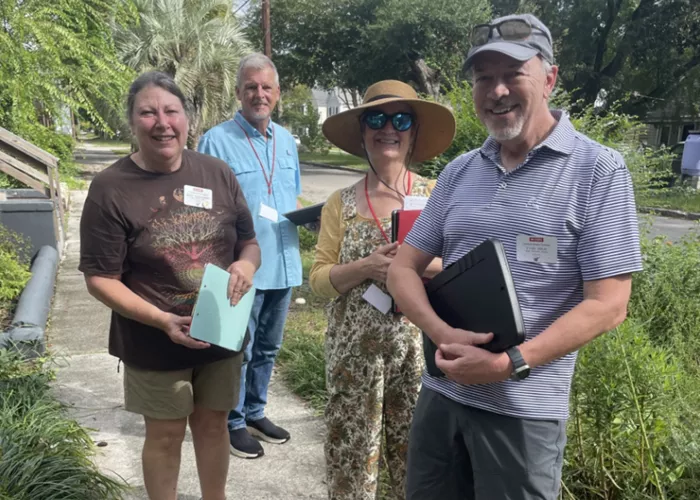The NC Cooperative Extension in New Hanover County offers a unique initiative called Nature at Home, designed to help residents learn about native plants and create better habitats for local wildlife. WHQR News Reporter Kelly Kenoyer explored this program by inviting experts to her home.
Since moving into her old house a few years ago, Kenoyer has been gradually improving her yard, which began as bare, sandy soil. While she has managed to plant some grass and a few plants, she admits her gardening skills are lacking. “I understood the soil and the rain back home in Oregon, but this sandy coastal stuff with monsoon summers? I have no idea,” she said.
To gain insight, Kenoyer invited four representatives from the NC Cooperative Extension to assess her yard. Evan Mauk, one of her guides, explained the purpose of the Nature at Home program: “We are ambassadors for the Nature at Home program at NC State, New Hanover County Extension Program. Our goal is to encourage and educate homeowners on growing plants that nurture animals, pollinators, and other wildlife.”
The program costs $30, and participants can become certified as a wildlife-friendly habitat. Mauk and his colleagues are available to assist those struggling with their gardening efforts, like Kenoyer. She pointed out a native plant she had tried to grow—a wilted tumbleweed bush—much to their dismay.
However, they did identify some positive aspects of her yard. Wendy Weidenhammer noted a thriving native Yaupon Holly, which will produce red or orange berries in the fall, providing food for birds in winter.
In her backyard, Kenoyer showcased various plants, including Virginia Creeper and Morning Glory vines, as well as a garden bed with canna lilies, camellias, native Blue Mist flowers, and elephant ears.
Mauk explained the five layers of habitat that need to be assessed for native plants: the canopy of tall trees, the understory of shorter trees, the shrub layer, herbaceous perennials, and ground covers.
After a follow-up visit a few weeks later, Kenoyer was surprised to learn that she nearly qualified for certification as a good habitat. However, she faced challenges from invasive species, particularly English Ivy and Kudzu, encroaching from her neighbors’ properties.
Colleen Higgins warned her about the work ahead: “You’re gonna have to make a stand.” Fortunately, the experts provided tips for managing these invasives. Kenoyer discovered that she had successfully established three layers of the forest with at least 30% native plants, along with beneficial elements like leaf litter and garden beds.
Despite the progress, the invasive plants still pose a significant problem. Once she tackles these issues and plants more native species, Kenoyer aims to achieve certification under the Nature at Home program.
To celebrate their collaboration, she invited her guests to admire her neighbor’s beautiful garden, filled with butterflies fluttering among black-eyed Susans and butterfly bushes. The experts were impressed, noting that with dedication, Kenoyer could create a similar low-maintenance native garden.
With their guidance and a plan in place, Kenoyer is ready to cultivate a vibrant and wildlife-friendly space in her yard. As Mauk reminded her, autumn is an ideal time for planting.
Related topics:
- Embracing Flaws: What Arabidopsis Thaliana Teaches Us About Nature’s Imperfections
- South Australian Tomato Farms to Stay in Quarantine for Months
- Colorado’s Poisonous, Carnivorous, and Strangest Plants


